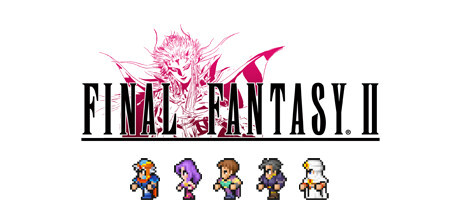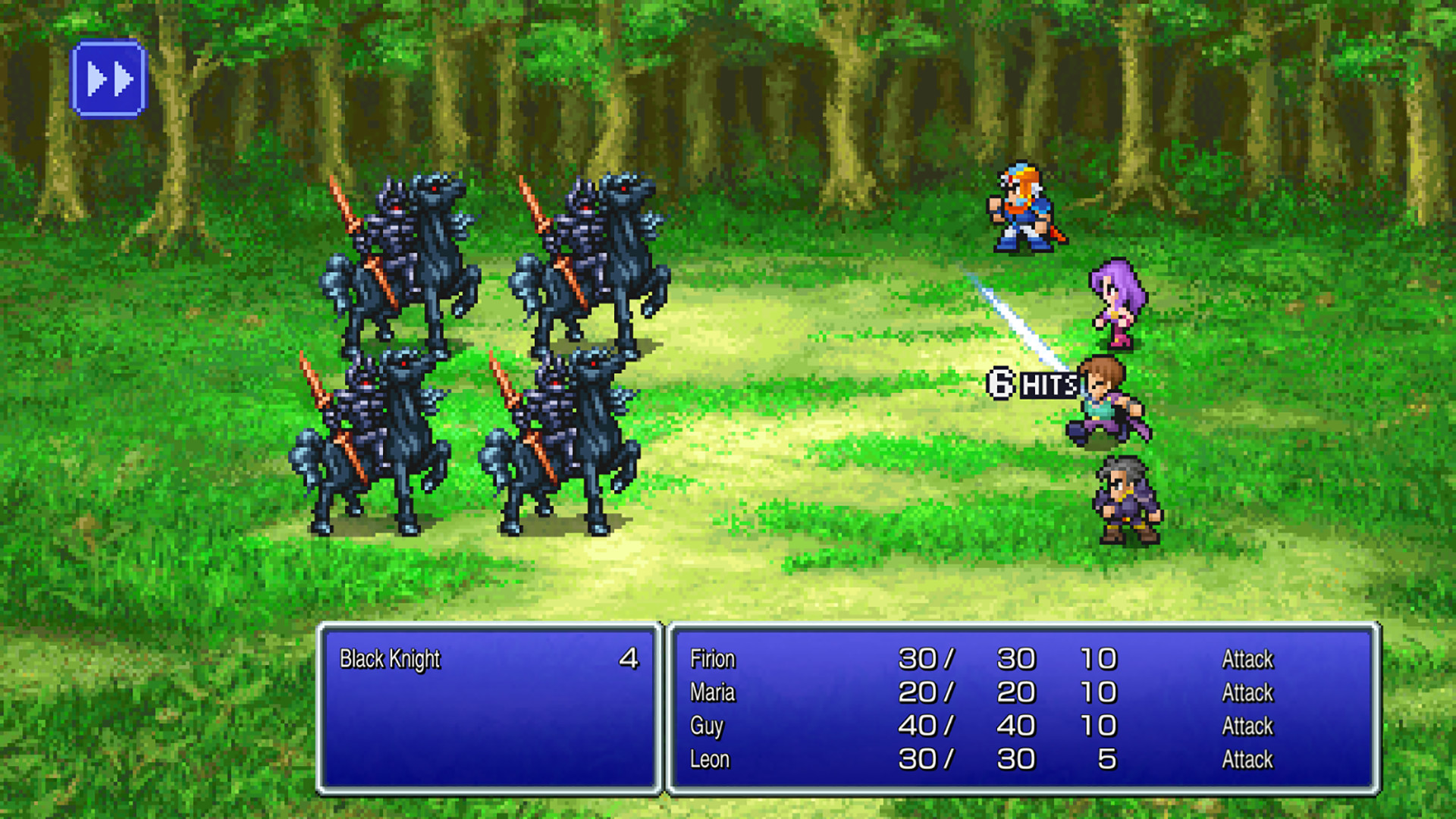Final Fantasy II Pixel Remaster
Jun. 17th, 2023 05:02 pm
The Godfather SaGa
Given its significant role in preventing Japanese video game developer and publisher Squaresoft from bankruptcy, it would have been unsurprising that they would commence work on a sequel to the original Final Fantasy, during the late 1980s when gamers outside Japan were relatively ignorant of whatever titles came from the country. The first sequel was initially to release in North America with the subtitle Dark Shadow Over Palakia, although its localization was ultimately cancelled, and Anglophones without Japan would miss out on the second sequel as well. The latest iteration of the game, Final Fantasy II Pixel Remaster, would first release for Android, iOS, and PC in 2021 and the Nintendo Switch and PlayStation 4 two years later.
The second Final Fantasy opens with mention of the Emperor of Palamecia taking over the world, and four war orphans: Firion, Guy, and the siblings Maria and Leon, cornered by imperial forces, suffering defeat at their hands yet waking in the headquarters of a rebel movement seeking to overthrow the empire. Cue anyone familiar with the original Star Wars trilogy to roll their eyes and lose interest in the narrative, and there are maybe a few scenes that directly rip off A New Hope. There are a few decent twists, with many guest characters coming and going in the player’s party throughout the game, before Leon ultimately rejoins, but the story is otherwise insignificant.
The translation is legible and free of spelling and grammar errors, although there are a few questionable and unexplained elements such as Guy’s caveman dialect, a few misleading and uninformative spell descriptions, especially for those that provide protection for the player’s party, and even some incorrect directions at one point on where to go next to advance the story.
As would be series tradition, Final Fantasy II mixes things in terms of gameplay. Encounters on the overworld and in dungeons (maybe rarely in an enemy-occupied town), are still random, and the structure of combat itself remains largely unchanged, with the typical setting of the player first inputting commands for all their characters and letting them and the enemy (which can number up to eight) beat each other up in a round, with the typical annoyance of the unclarity of who goes when, which can lead to certain unfavorable situations such as wasting healing items on characters that ultimately get killed.
Significant mix-up comes in the abolition of experience-based character progression, replaced by that based on combat activity, which would be central to the SaGa series that one of the directors, Akitoshi Kawazu, would go on to develop. For instance, the more a character uses a certain class of weapons, the more proficient he/she will become with it, both increasing the strength and number of hits with said armament for each proficiency level advancement. Furthermore, maximum HP may increase after combat depending upon how much damage characters have sustained, provided they survive battle, with occasional gratuitous max health increases after a c certain number of battles as well.

The Star Wars reference here is coincidental.
The magic system also bears significant changes. Players have characters learn magic through special spellbooks representing certain magical abilities, which include the HP-recovering Cure, the elemental Fire/Ice/Thunder spells and more, and support enhancements such as the physical defense-increasing Protect. Each spell has an initial cost of one MP, with maximum increases obtained through the constant exhaustion of spells, which also gradually increases the level of the consumed magic, giving it more damage, accuracy, effect, etc., their ultimate cost of use reflecting their current levels.
The other increasable stats of the player’s party follow similar rules and battles themselves typically don’t last too long unless the player is attempting to really grind their party, with all fights ending with the acquisition of money alongside said common stat increases due to their various actions. Several guest characters come and go throughout the game, ending with Leon, and players may find it wise not to grind the fourth guest character until Leon becomes the final party member. Things can become somewhat rough on the default difficulty settings, although as with its preceding Pixel Remaster, several Boosts can significantly soften the blow, and the second Final Fantasy’s take on non-experience-based combat ends up being better than that throughout the SaGa series.
As a fellow Pixel Remaster, Final Fantasy II’s control has many of the same pluses and negatives as its predecessor, among the former being the default auto-dash setting in towns and dungeons, the easy menus, helpful dungeon maps, suspend save, items stacking and no limit on inventory existing unlike a few earlier remakes of the game, and so forth. One interesting system indigenous to the first series sequel is a system where a simultaneous tone and highlight of a word in dialogue allows players to learn keywords and select them to get more information, sometimes critical towards plot advancement, and is creative and unobstructive.
Among control’s weaknesses, however, include the slow overworld movement, sometimes-poor direction on how to advance the central narrative (with the above-mentioned incorrect directive on where said plot point is not helping at that point), the game’s auto-equip feature not considering the affinities of armament types and shields when automatically outfitting characters with the gear from their inventory, the absence of teleportation magic among visited towns and dungeons (though dungeon-exiting magic is present), and occasional misinformation when shopping about how shields increase defense. Still, the sequel interacts decently with players.

The keyword system still remains fairly unique to this day within and without the series.
Akin to its predecessor, Nobuo Uematsu’s soundtrack dazzles in the Pixel Remaster, given full-fledged orchestration, with the title screen, for starters, featuring a remix of the iconic series overture. The tracks within the game itself are solid as well, such as the bombastic standard battle music, the rebels’ theme, the peaceful town tune, the foreboding overworld and dungeon themes, and so on. There are even versions of public domain classical music such as the “Swan Theme” from Tchaikovsky’s Swan Lake and Strauss’s “Emperor Waltz”. There are only minor issues such as the repetitiveness of the battle theme and missing sounds such as villain Borghen’s laugh, like Kefka’s in the sixth game, but otherwise, Final Fantasy II is an absolute delight to listen to.
The Pixel Remaster evokes most of the same feelings visually, given the bright colors, pretty environments, excellent character and enemy designs, the flashy battle effects especially from the magic spells whose appearances intensify with higher levels, the dodge and blocking animations of characters in combat, the weather and illumination effects, et cetera. Granted, many of the same graphical issues with the first of the latest Final Fantasy remakes recur such as the inanimate enemies that also bear countless reskins, and the telekinetic physical attacks by characters in battle, but otherwise, the visual aspect helps far more than hurts.
Finally, the latest incarnation of the first series sequel is a little longer than its predecessor, taking somewhere from twelve to twenty-four hours to finish, with plenty lasting appeal in the form of PlayStation Trophies, completing the bestiary, the adjustable difficulty, the countless growth paths, and so on, although there isn’t any narrative variation in subsequent playthroughs.
In summation, the Pixel Remaster of Final Fantasy II is undoubtedly the definitive version of the game, to the point where a full-fledged remake would be unnecessary, given its oddball mechanics made more merciful and accommodating to novice players with the Boost system, the general tight control, and solid audiovisual presentation. However, the narrative hasn’t really aged well and was in its time derivative, and there are a few issues with the control, translation, and visuals. Regardless, it would be influential in the inception of Squaresoft’s sister SaGa series headed by Kawazu, although this godfather of that franchise did things better than any entry of that franchise ever would.
This review is based on a playthrough of a digital copy downloaded to the player's PlayStation 4 with the easiest Boost options enacted.
| Score Breakdown | |
|---|---|
| The Good | The Bad |
|
|
| The Bottom Line | |
| Another solid Pixel Remaster. | |
| Platform | PlayStation 4 |
| Game Mechanics | 8.0/10 |
| Control | 7.0/10 |
| Story | 3.0/10 |
| Localization | 5.0/10 |
| Aurals | 9.5/10 |
| Visuals | 7.5/10 |
| Lasting Appeal | 9.0/10 |
| Difficulty | Adjustable |
| Playtime | 12-24 Hours |
| Overall: 7.0/10 | |
